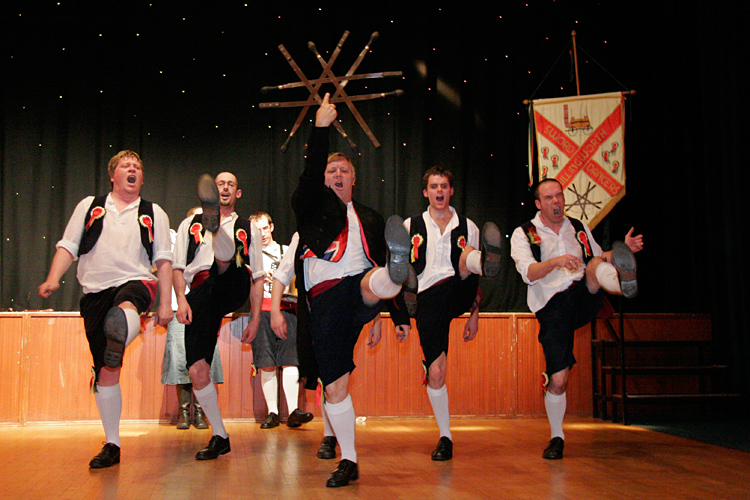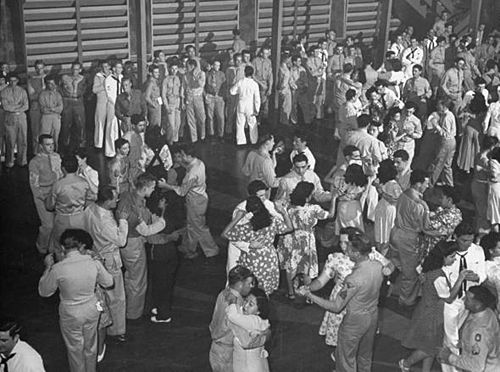Rapper Dancing
What is Rapper dancing?
 Rapper sword, which is also known as the "Short Sword" dance, is a type of sword dance that came from the pit villages of Tyneside in North East England, where the miners first created the tradition. The dance needs five performers who co-ordinate themselves whilst using "rapper swords" made of relatively flexible steel. Joined by traditional folk music, the dancers will wear specially-designed shoes that allow for percussive foot movements. Mental awareness, in addition to physical agility, is needed in order for dancers to use the swords effectively without causing harm to themselves or the others around them.
Rapper sword, which is also known as the "Short Sword" dance, is a type of sword dance that came from the pit villages of Tyneside in North East England, where the miners first created the tradition. The dance needs five performers who co-ordinate themselves whilst using "rapper swords" made of relatively flexible steel. Joined by traditional folk music, the dancers will wear specially-designed shoes that allow for percussive foot movements. Mental awareness, in addition to physical agility, is needed in order for dancers to use the swords effectively without causing harm to themselves or the others around them.
History
Hilt-and-point sword dances comes from all around Europe, with the dance practised in Germany, Austria and Flanders show a big resemblance to the dance forms coming from the rapper dance of Northumberland and Durham, and the longsword dance of Yorkshire, which uses rigid swords.
 The earliest account of hilt-and-point sword dancing in England goes all the way back to an article in 1715 describing a dance in the Tyne Valley to the west of Newcastle upon Tyne. The dance is described to be somewhat similar to linked sword dances of the Yorkshire and continental version rather than the rapper dance. Later findings and observations in the same century describe the dance in much more detail, and even though rigid swords continue to be used, some aspects of the modern dance already occur, including the male and ‘female’ characters and the close connection between the dance and coal mining.
The earliest account of hilt-and-point sword dancing in England goes all the way back to an article in 1715 describing a dance in the Tyne Valley to the west of Newcastle upon Tyne. The dance is described to be somewhat similar to linked sword dances of the Yorkshire and continental version rather than the rapper dance. Later findings and observations in the same century describe the dance in much more detail, and even though rigid swords continue to be used, some aspects of the modern dance already occur, including the male and ‘female’ characters and the close connection between the dance and coal mining.
At this point in time, the dance was only performed during midwinter and was a big part of a longer performance starting with a short play. The play looked like a mummers play with historical characters, fake executions and resurrections of the dead by doctors – these were meant to show death and rebirth, and these symbolic midwinter rituals were common in northern Europe. Pretend executions were sometimes also a part of the dance, just like they still are in many longswords and mainland sword dances.
The starter of the flexible rapper that replaced the rigid sword occurred at some point in the nineteenth century. The actual date is unknown, but the rapper was definitely being used by 1880, there is also some unreliable evidence that it may have been as early as 1820. There is not yet any knowledge of how the rapper came to be – but it is very likely that it was found by accident when mining tools were changed to be used as pretend swords. It is surely known that later on, rapper teams created rappers from bed laths or by filing down the teeth of saw blades; sometimes these pit tools were donated by a sympathetic manager from the mine, but they would most likely just be recycled discarded old tools.
Prior to the invention of the Gilchrist-Thomas lining for the Bessemer converter in 1878, high-quality steel was very expensive, as British iron ore was far too high in phosphorus content for the manufacture of steel, and so we brought over iron ore from Sweden for making steel. Steel of the quality that was needed for rappers was therefore also very expensive, so it was almost definitely beyond the means of the average coal miner to purchase purpose-made rappers, and the Earsdon team had regularly been performing with the more common flexible rappers for 20 years prior to this. This also encourages the theory that rappers were made from older mining tools.
The unearthing of the flexible swords created the chance for significant innovations in the style of the dance, to the point where it became entirely different from other dances like longsword. Indeed, the very easy structure of the dance changed from dancers moving around in a circle to two circles meeting together to make a figure-of-eight pattern. The drastic change in the form of the dance and the common standard of a few simple figures used in most traditional dances suggest that the changes to the dance were created in one place, maybe by one clever person, and later spread out.
Examples
Dance crews
Unfortunately, there are far too many dance teams for me to be able to put them all in however these are a few that I found:
 Newcastle upon tyne:
Newcastle upon tyne:
Newcastle Kingsmen Sword Dancers
Location: Newcastle upon Tyne
Gender: Male
Rapper traditions: Kingsmen, Byker Buildings
Other traditions: Longsword, Northwest
Contact: James Boyle
E-mail: squire@kingsmen.co.uk
WWW: www.kingsmen.co.uk
Pengwyn Rapper
Location: Newcastle upon Tyne / Darlington
Gender: Female
Contact: Catherine Hyde Wesson
E-mail: CAHydeWesson@aol.com
Sallyport Sword Dancers
Location: Newcastle upon Tyne
Gender: Male
Rapper traditions: Newbiggin, Winlaton, Beadnell, Murton, Swalwell
Contact: Vince Rutland
E-mail: vince@srutland.orangehome.co.uk
WWW: sallyport.heroku.com
Short Circuit
Location: Newcastle upon Tyne
Gender: Female
Other dances: Clog
Contact: Hazell Hall
E-mail: hazellhall@hotmail.com
Yorkshire:
Black Swan Rapper
Location: York
Gender: Male
Contact: Damien Barber
E-mail: blackswanrapper@hotmail.com
 Gift Rapper
Gift Rapper
Location: Sheffield
Gender: Female
Other traditions: Longsword
Triskele Sword
Location: Sheffield
Gender: Mixed
Contact: Jenny Day
E-mail: jennyday@talktalk.net
WWW: www.triskelesword.co.uk
USA:
Iron Mountain Sword
Location: Portland, OR
Gender: Mixed
Other Traditions: Salton Longsword
Contact: Dave Macemon
E-mail: macemon_dave@comcast.net
Rattle Up
 Location: Pasadena, CA
Location: Pasadena, CA
Gender: Male
Rapper traditions: Winlaton, North Walbottle
Other traditions: Border Stick
Contact: Mike Tyszka
E-mail: jmt@gg.caltech.edu
Swords of Gridlock
Location: Berkeley, CA
Gender: Mixed
Contact: Randall Cayford
E-mail: randall@cayford.org
Competitions
From after the great war, all the way up until the fifties Newcastle upon tyne was the home to a competition called The Newcastle Tournament of Music and Art. In this tournament, they would hold a section for senior and also junior Rapper sword dancing. It took place in the city hall.
The event had many different musical acts and performance classes held over most of a week. However, it was the Saturday Rapper competition that drew the most crowds. The judges were imported from the London-based, English Folk Dance Society as rapper dance was so admired.
Another competition that is very widely known about in the rapper community is the DERT competition. DERT stands for “Dancing England Rapper Tournament.” The competition tours the country and is organised by a different rapper team every year with support provided by previous DERT organisers, the bigger rapper community and the Sword Dance Union. In other years it has been an international competition, with past entries from teams from such as the USA, Denmark, Canada and Norway. Between 25 and 30 teams compete for all kinds of prizes, accolades and bragging rights for the following year. Entries are divided into three different divisions; Premier, Championship and also Open with potential promotions and demotions happening depending on how the teams dance. Musicians compete too, along with the Tommy and Betty characters employed by most of the sword dance groups.
Harry Theaker
 Harry Came into class to show us some of the movement, he also taught us some well-known choreography as well. Harry is a contemporary performer/ choreographer whose career has spanned two decades of dance-making and performance of his own work, as well as working with dance companies all over the world and co-founding Vincent Dance Theatre, he has also been performing rapper sword dance for many years as well.
Harry Came into class to show us some of the movement, he also taught us some well-known choreography as well. Harry is a contemporary performer/ choreographer whose career has spanned two decades of dance-making and performance of his own work, as well as working with dance companies all over the world and co-founding Vincent Dance Theatre, he has also been performing rapper sword dance for many years as well.
Here is our own attempt at a whisk into the horse and carriage
https://www.youtube.com/watch?v=hSAPbK_M4UE&feature=youtu.be

















